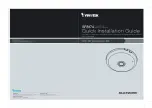
DFE-650 Series Fast Ethernet PC Card User's Guide
36
Troubleshooting
items on the short list is the culprit (conflicting driver). And that
method is trial and error. So we begin testing each of the items on
the short list in turn. We take the items in the same order as they
appear in the short list (because taking them in that order will
ordinarily lead us to the earliest success). LSL is the first item on
our example short list, so we begin our trial-and-error round by
starting with LSL and following this procedure:
1.
Find the AUTOEXEC.BAT line which invokes the first item
in your short list (LSL in our example):
At the DOS prompt (here represented by
C:\>
), type
C:\> find /n/i "LSL" autoexec.bat
then
<RETURN>. T
his will display the line from
AUTOEXEC.BAT which causes the LSL program to be
loaded.
---------- AUTOEXEC.BAT
[2]C:\ODI.DOS\LSL.COM
Ignore the header line of the display, which only identifies the
subject file. To help locate the LSL line of the
AUTOEXEC.BAT file, the line's line number in
AUTOEXEC.BAT is shown in brackets to the left of the
actual text of the line. If LSL appears in more than one line of
AUTOEXEC.BAT, then you will need to decide which of the
several lines is the one that causes loading
––
but it is most
likely that any additional lines will simply be remark lines,
which you can ignore.
Note that in this step, you must name the first item of your
short list, rather than LSL, which is used here only for
purposes of example.
2.
Edit AUTOEXEC.BAT to cancel out that line.
At the DOS prompt (here represented by
C:\>
), type










































